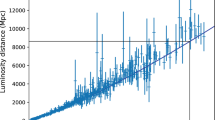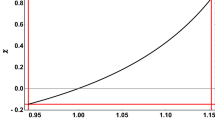Abstract
Dirac’s large number hypothesis (LNH), in the formG/G 0=HH −10 , is applied to the matter-dominated cosmological era, using the framework of the scale covariant theory (Canuto et al., 1977). We obtain explicit expressions forR andβ a as functions ofR E , whereR andR E are the scale factors of the cosmological Robertson-Walker metric, expressed in atomic and gravitational units, respectively, andβ a is the ratio between the rates of gravitational and atomic clocks. The parameters in these expressions are\(\bar q_0 \), the deceleration parameter in gravitational units, and\(\dot \beta _a \)(t 0)H −10 where\(\dot \beta _a \)(t 0) is the present epoch value of the derivative ofβ a with respect to atomic time. We find that a necessary condition for the LNH to be compatible with a Robertson-Walker model is that\(\dot \beta _a \)(t 0)H −10 ≥ 12 . The only experimental values for\(\dot \beta _a \)(t 0) available at present are those based on the lengthening of the Moon’s period of revolution around the Earth, suggesting 0.86≥\(\dot \beta _a \)(t 0)H −10 ≥0.21; the more promising technique of radar ranging to the inner planets has not yet produced a value for\(\dot \beta _a \)(t 0). Using the lunar data, it follows that 0≤\(\bar q_0 \)≲0.42 corresponding to an open universe (k=−1). Closed models (k=1,\(\bar q_0 \)>1/2) are not compatible with the LNH since the required values of\(\dot \beta _a \)(t 0)H −10 are more than an order of magnitude above the observational upper limit.
Similar content being viewed by others
References
Canuto, V. M., Adams, P. J., Hsieh, S.-H., and Tsiang, E. (1977).Physical Review D,16, 1643.
Canuto, V. M., and Hsieh, S.-H. (1980).Physical Review Letters,44, 695.
Canuto, V. M., Hsieh, S.-H., and Owen, J. R. (1980).Astrophysical Journal,241, 886.
Canuto, V. M., and Goldman, I. (1982).Nature (April 22).
Dirac, P. A. M. (1937).Nature,139, 323.
Dirac, P. A. M. (1973).Proceedings of the Royal Society of London,A333, 403.
Dirac, P. A. M. (1974).Proceedings of the Royal Society of London,A338, 439.
Dirac, P. A. M. (1978). InOn the Measurements of the Cosmological Variations of the Gravitational Constant, ed. Halpern, L., University of Florida Press, Gainesville, Florida.
Shapiro I. I. (1981). Lecture delivered at the Dirac Conference, Loyola University, New Orleans.
Van Flandern, T. C. (1981).Astrophysical Journal,248, 873.
Weinberg, S. (1972).Gravitation and Cosmology, John Wiley, New York.
Yang, J., Schramm, D. N., Steigman, G., and Rood, R. T. (1979).Astrophysical Journal,227, 697.
Author information
Authors and Affiliations
Rights and permissions
About this article
Cite this article
Goldman, I. Large number hypothesis and the matter-dominated universe. Int J Theor Phys 21, 665–672 (1982). https://doi.org/10.1007/BF02650232
Received:
Issue Date:
DOI: https://doi.org/10.1007/BF02650232




